Impact of a Thermal Barrier Coating in Low Heat Rejection Environment Area of a Diesel Engine
Abstract
:1. Introduction
- The system was designed to improve the diesel engine with certain modified parameters such as Thermal Barrier Coating on the piston crown and valve surface based on a thorough literature review;
- The conventional diesel engine was aimed renewed to an LHR engine by applying 0.5 mm thickness of 3Al2O3-2SiO2 (as TBC) onto the piston crown and valves;
- In addition, an alternative fuel was used to reduce emissions with a low heat rejection system;
- Mahua oil was selected for investigation with TBC due to more O2 content present in Mahua oil.
2. Low Heat Rejection Engine
Selection of TBC Material for IC Engines
- Chemical inertness;
- Good adherence capability with a metallic substrate;
- Higher melting point of a material;
- Lower thermal conductivity of a material;
- At room temperature, no phase changes take place;
3. Transesterification Process
4. Fuel Properties
5. Experimental Setup Description
5.1. Engine Test
5.2. AVL 444 Gas Analyzer
- Ensure that the power supply meets the manufacturer’s specifications and that the electrical earthing is correct;
- Ensure that all of the accessories specified by the manufacturer are present and functional;
- Validate the span and zero calibration with suitable CO and HC sample gases;
- Examine the electrical calibration;
- Ensure that the sampling system is leak-free;
- The printer is operational, and the printout details are correct;
- Using this analyzer, check one vehicle for idling emission measurement.
5.3. Specification of AVL Smoke Meter and its Operating Conditions
- Warm-up time:20 min (max.) at 220 V Supply;
- Operating temperature:0–50 °C;
- Relative humidity:90% at 50 °C relative humidity (non condensing).
5.4. Percentage Uncertainties of Calculated Parameters
6. Results and Discussion
6.1. Performance and Emission Parameters
6.1.1. Brake Specific Fuel Consumption
6.1.2. Brake Thermal Efficiency
6.1.3. Exhaust Gas Temperature
6.1.4. Smoke Density
6.1.5. CO Emissions
6.1.6. HC Emissions
6.1.7. NOx Emissions
7. Conclusions
Author Contributions
Funding
Institutional Review Board Statement
Informed Consent Statement
Data Availability Statement
Conflicts of Interest
References
- Nandi, S. Performance of CI engine by using biodiesel-mahua oil. Am. J. Eng. Res. 2013, 2, 22–47. [Google Scholar]
- Padhi, S.K.; Singh, R.K. Optimization of esterification and transesterification of Mahua (Madhuca Indica) oil for production of biodiesel. J. Chem. Pharm. Res. 2010, 2, 599–608. [Google Scholar]
- Agarwal, A.; Das, L.M. Biodiesel Development and Characterization for Use as a Fuel in Compression Ignition Engines. J. Eng. Gas Turbines Power 2001, 123, 440–447. [Google Scholar] [CrossRef]
- Padhi, S.K.; Singh, R.K. Non-edible oils as the potential source for the production of biodiesel in India: A re-view. J. Chem. Pharm. Res. 2011, 3, 39–49. [Google Scholar]
- Vijay Kumar, M.; Veeresh Babu, A.; Ravi Kumar, P. Producing biodiesel from crude Mahua oil by two steps of trans-esterification process. Aust. J. Mech. Eng. 2019, 17, 2–7. [Google Scholar] [CrossRef]
- Azam, M.M.; Waris, A.; Nahar, N. Prospects and potential of fatty acid methyl esters of some non-traditional seed oils for use as biodiesel in India. Biomass Bioenergy 2005, 29, 293–302. [Google Scholar] [CrossRef]
- Chauhan, P.S.; Chhibber, V.K. Non-edible oil as a source of bio-lubricant for industrial applications: A re-view. Int. J. Eng. Sci. Innov. Technol. 2013, 2, 299–305. [Google Scholar]
- Sirurmath, S.; Vikram, P.M.; Das, G. Transesterification of Fish Oil and Performance Study on 4-Stroke CI Engine with Blends of Fish Biodiesel. IJRET Int. J. Res. Eng. Technol. 2014, 3, 608–612. [Google Scholar]
- Tipanluisa, L.; Fonseca, N.; Casanova, J.; López, J.-M. Effect of n-butanol/diesel blends on performance and emissions of a heavy-duty diesel engine tested under the World Harmonised Steady-State cycle. Fuel 2021, 302, 121204. [Google Scholar] [CrossRef]
- Şahin, Z.; Aksu, O.N. Experimental investigation of the effects of using low ratio n-butanol/diesel fuel blends on engine performance and exhaust emissions in a turbocharged DI diesel engine. Renew. Energy 2015, 77, 279–290. [Google Scholar] [CrossRef]
- Lapuerta, M.; Hernández, J.J.; Rodríguez-Fernández, J.; Barba, J.; Ramos, A.; Fernández-Rodríguez, D. Emission benefits from the use of n-butanol blends in a Euro 6 diesel engine. Int. J. Engine Res. 2018, 19, 1099–1112. [Google Scholar] [CrossRef]
- Nayyar, A.; Sharma, D.; Soni, S.L.; Mathur, A. Experimental investigation of performance and emissions of a VCR diesel engine fuelled with n-butanol diesel blends under varying engine parameters. Environ. Sci. Pollut. Res. 2017, 24, 20315–20329. [Google Scholar] [CrossRef] [PubMed]
- Siwale, L.; Kristóf, L.; Adam, T.; Bereczky, A.; Mbarawa, M.; Penninger, A.; Kolesnikov, A. Combustion and emission characteristics of n-butanol/diesel fuel blend in a turbo-charged compres-sion ignition engine. Fuel 2013, 107, 409–418. [Google Scholar] [CrossRef]
- Maricq, M.; Chase, R.; Podsiadlik, D.; Vogt, R. Vehicle exhaust particle size distributions: A comparison of tailpipe and dilution tunnel measure-ments. SAE Trans. 1999, 108, 721–732. [Google Scholar]
- Shi, J.P.; Mark, D.; Harrison, R.M. Characterization of Particles from a Current Technology Heavy-Duty Diesel Engine. Environ. Sci. Technol. 2000, 34, 748–755. [Google Scholar] [CrossRef]
- Myung, C.L.; Park, S. Exhaust nanoparticle emissions from internal combustion engines: A review. Int. J. Automot. Technol. 2011, 13, 9–22. [Google Scholar] [CrossRef]
- Vu, T.V.; Delgado-Saborit, J.M.; Harrison, R.M. Review: Particle number size distributions from seven major sources and implications for source apportionment studies. Atmos. Environ. 2015, 122, 114–132. [Google Scholar] [CrossRef]
- Fangrui, M.; Hanna, M.A. Biodiesel production: A review. Bioresour. Technol. 1999, 70, 1–15. [Google Scholar]
- Yusuf, N.; Kamarudin, S.; Yaakub, Z. Overview on the current trends in biodiesel production. Energy Convers. Manag. 2011, 52, 2741–2751. [Google Scholar] [CrossRef]
- Wellert, S.; Karg, M.; Imhof, H.; Steppin, A.; Altmann, H.J.; Dolle, M.; Richardt, A.; Tiersch, B.; Koetz, J.; Lapp, A.; et al. Structure of biodiesel based bicontinuous microemulsions for environmentally compatible decontamina-tion: A small angle neutron scattering and freeze fracture electron microscopy study. J. Colloid Interface Sci. 2008, 325, 250–258. [Google Scholar] [CrossRef]
- de Jesus, A.; Silva, M.M.; Vale, M.G.R. The use of microemulsion for determination of sodium and potassium in biodiesel by flame atomic absorption spectrometry. Talanta 2008, 74, 1378–1384. [Google Scholar] [CrossRef] [PubMed]
- Ding, X.; Yuan, X.; Leng, L.; Huang, H.; Wang, H.; Shao, J.; Jiang, L.; Chen, X.; Zeng, G. Upgrading Sewage Sludge Liquefaction Bio-Oil by Microemulsification: The Effect of Ethanol as Polar Phase on Solubilization Performance and Fuel Properties. Energy Fuels 2017, 31, 1574–1582. [Google Scholar] [CrossRef]
- Leng, L.; Han, P.; Yuan, X.; Li, J.; Zhou, W. Biodiesel microemulsion upgrading and thermogravimetric study of bio-oil produced by liquefaction of different sludges. Energy 2018, 153, 1061–1072. [Google Scholar] [CrossRef]
- Karaoglanli, A.C.; Dikici, H.; Kucuk, Y. Effects of heat treatment on adhesion strength of thermal barrier coating systems. Eng. Fail. Anal. 2013, 32, 16–22. [Google Scholar] [CrossRef]
- Buyukkaya, E.; Cerit, M. Experimental study of NOx emissions and injection timing of a low heat rejection diesel engine. Int. J. Therm. Sci. 2008, 47, 1096–1106. [Google Scholar] [CrossRef]
- Cao, X.Q.; Vassen, R.; Stoever, D. Ceramic materials for thermal barrier coatings. J. Eur. Ceram. Soc. 2004, 24, 1–10. [Google Scholar] [CrossRef]
- MohamedMusthafa, M.; Sivapirakasam, S.; Udayakumar, M. Comparative studies on fly ash coated low heat rejection diesel engine on performance and emission characteristics fueled by rice bran and pongamia methyl ester and their blend with diesel. Energy 2011, 36, 2343–2351. [Google Scholar] [CrossRef]
- Jia, L.; Wen, T.; Tian, C.; Liu, Z.; Yu, J.; Yuan, L. Preparation and thermophysical properties of RE2CrTaO7 (Y, Sm, Dy, Yb) ceramics for thermal barrier coating applications. Ceram. Int. 2022, 48, 23814–23820. [Google Scholar] [CrossRef]
- Lima, C.; Guilemany, J. Adhesion improvements of Thermal Barrier Coatings with HVOF thermally sprayed bond coats. Surf. Coatings Technol. 2007, 201, 4694–4701. [Google Scholar] [CrossRef]
- Gatowski, J.A. Evaluation of a selectively-cooled single-cylinder 0.5-l Diesel engine. SAE Trans. 1990, 99, 1580–1591. [Google Scholar]
- Shen, Z.; Liu, G.; Dai, J.; He, L.; Mu, R. LaNdZrO thermal barrier coatings by electron beam physical vapor deposition: Morphology, thermal property and failure mechanism. Chem. Eng. J. Adv. 2022, 11, 100328. [Google Scholar] [CrossRef]
- Mondal, K.; Nuñez, L., III; Downey, C.M.; van Rooyen, I.J. Recent advances in the thermal barrier coatings for extreme environments. Mater. Sci. Energy Technol. 2021, 4, 208–210. [Google Scholar] [CrossRef]
- Vaßen, R.; Bakan, E.; Mack, D.E.; Guillon, O. A Perspective on Thermally Sprayed Thermal Barrier Coatings: Current Status and Trends. J. Therm. Spray Technol. 2022, 31, 685–698. [Google Scholar] [CrossRef]
- Mondal, K.; Nuñez, L., III; Downey, C.M.; Van Rooyen, I.J. Thermal barrier coatings overview: Design, manufacturing, and applications in high-temperature industries. Ind. Eng. Chem. Res. 2021, 60, 6061–6077. [Google Scholar] [CrossRef]
- Kamo, R.; Assanis, D.N.; Bryzik, W. Thin Thermal Barrier Coatings for Engines. SAE Trans. 1989, 98, 131–136. [Google Scholar] [CrossRef]
- Abedin, M.J.; Masjuki, H.H.; Kalam, M.A.; Sanjid, A.; Ashraful, A.M. Combustion, performance, and emission characteristics of low heat rejection engine operating on various biodiesels and vegetable oils. Energy Convers. Manag. 2014, 85, 173–189. [Google Scholar] [CrossRef]
- Kumar, M.V.; Veeresh Babu, A.; Ravi Kumar, P. Experimental investigation on mahua methyl ester blended with diesel fuel in a compression ignition diesel engine. Int. J. Ambient. Energy 2019, 40, 304–316. [Google Scholar] [CrossRef]
- Vijay Kumar, M.; Babu, A.V.; Kumar, P.R.; Reddy, S.S. Experimental investigation of the combustion characteristics of Mahua oil biodiesel-diesel blend using a DI diesel engine modified with EGR and nozzle hole orifice diameter. Biofuel Res. J. 2018, 5, 863–871. [Google Scholar] [CrossRef] [Green Version]
- Basaran, H.U.; Ozsoysal, O.A. Effects of application of variable valve timing on the exhaust gas tem-perature improvement in a low-loaded diesel engine. Appl. Therm. Eng. 2017, 122, 758–767. [Google Scholar] [CrossRef]
- Hegab, A.; Dahuwa, K.; Islam, R.; Cairns, A.; Khurana, A.; Shrestha, S.; Francis, R. Plasma electrolytic oxidation thermal barrier coating for reduced heat losses in IC engines. Appl. Therm. Eng. 2021, 196, 117316. [Google Scholar] [CrossRef]
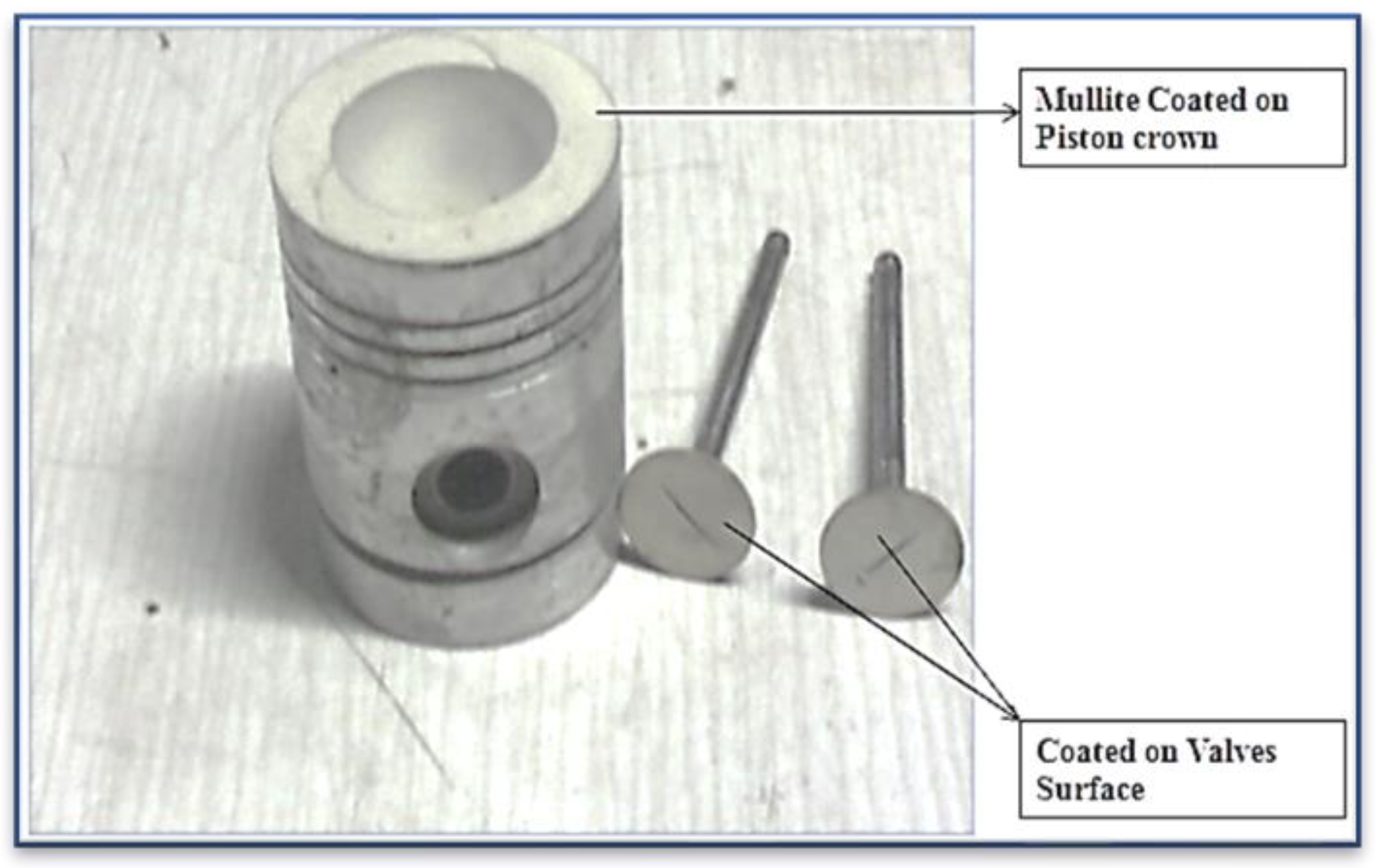
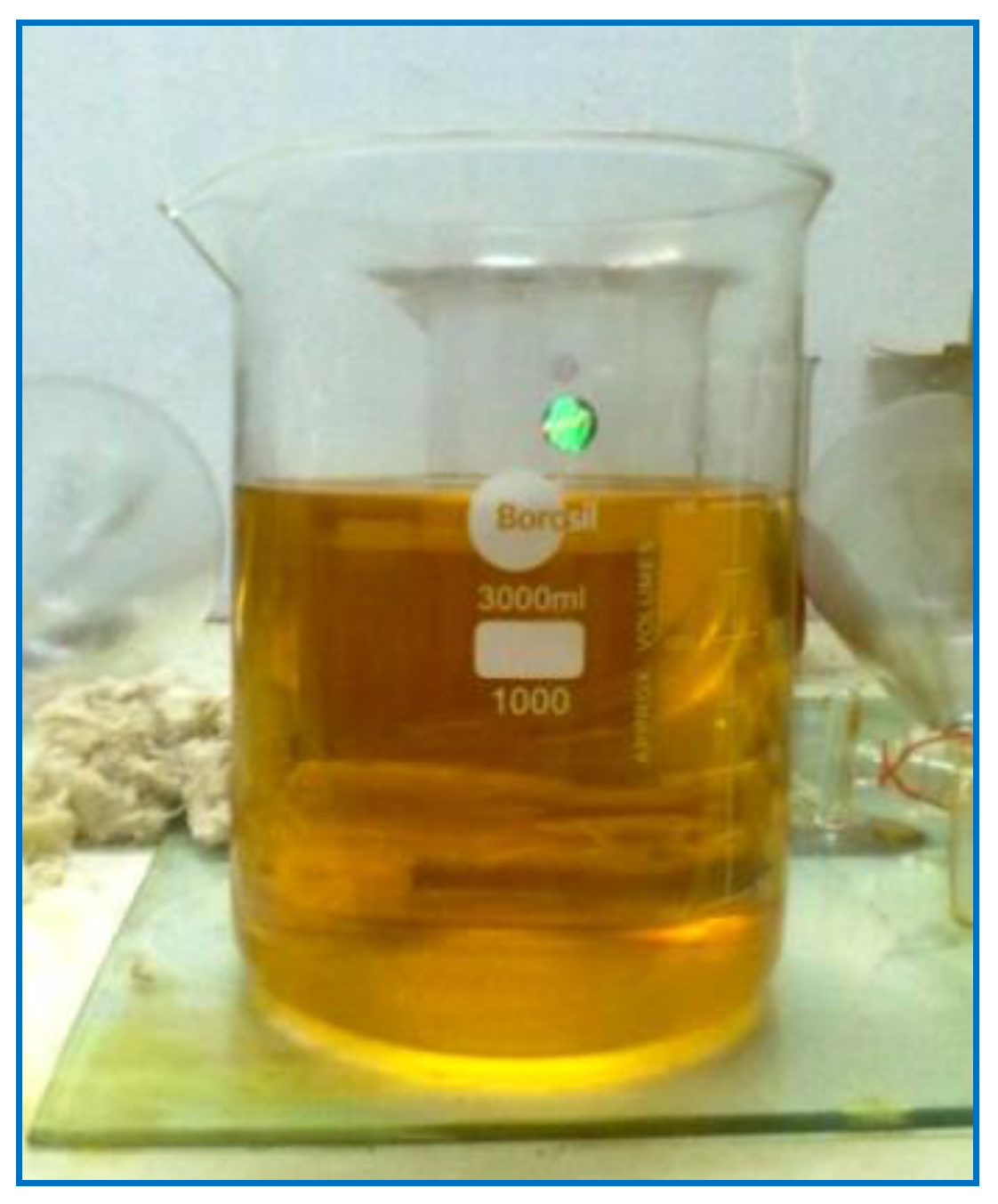

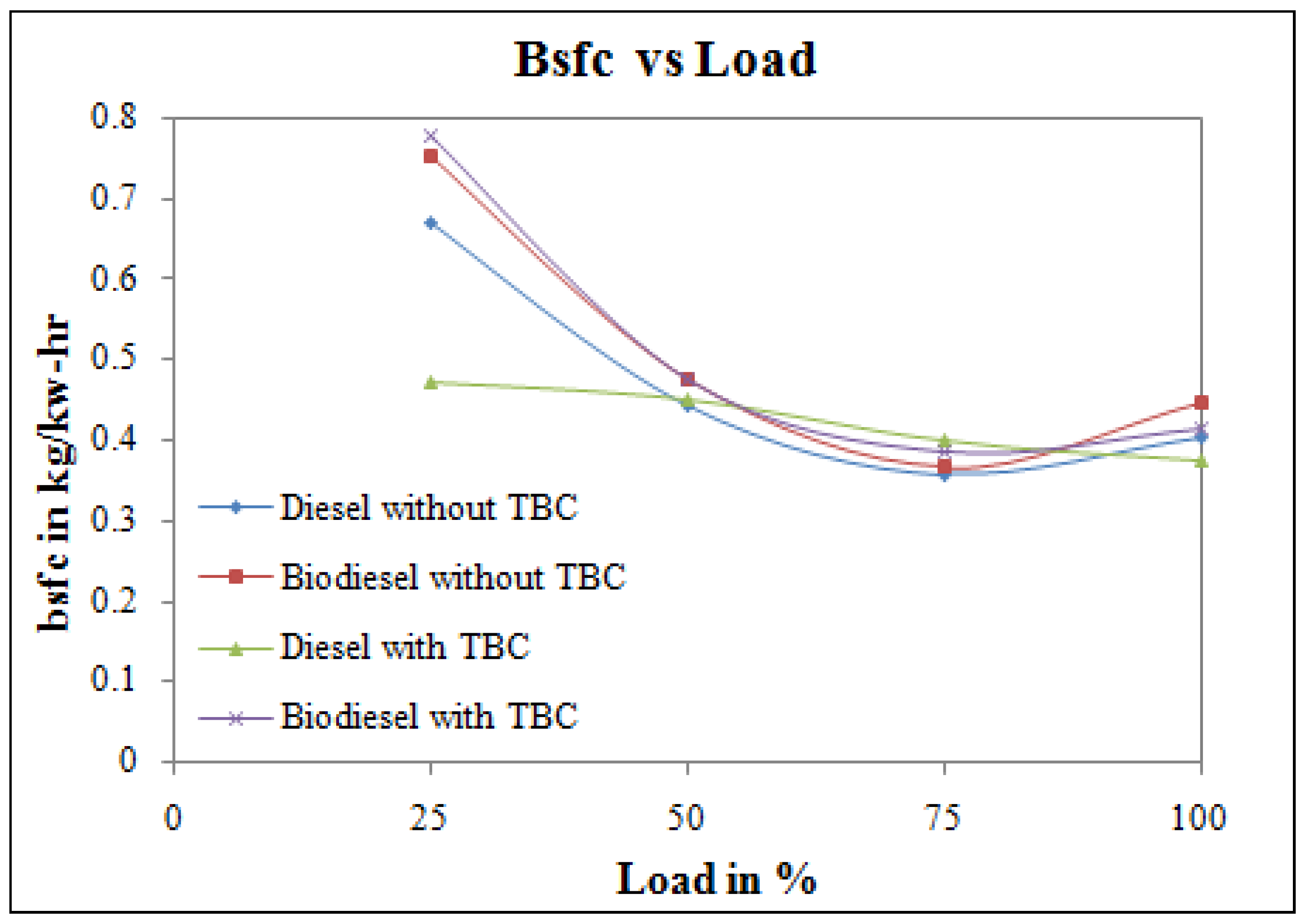


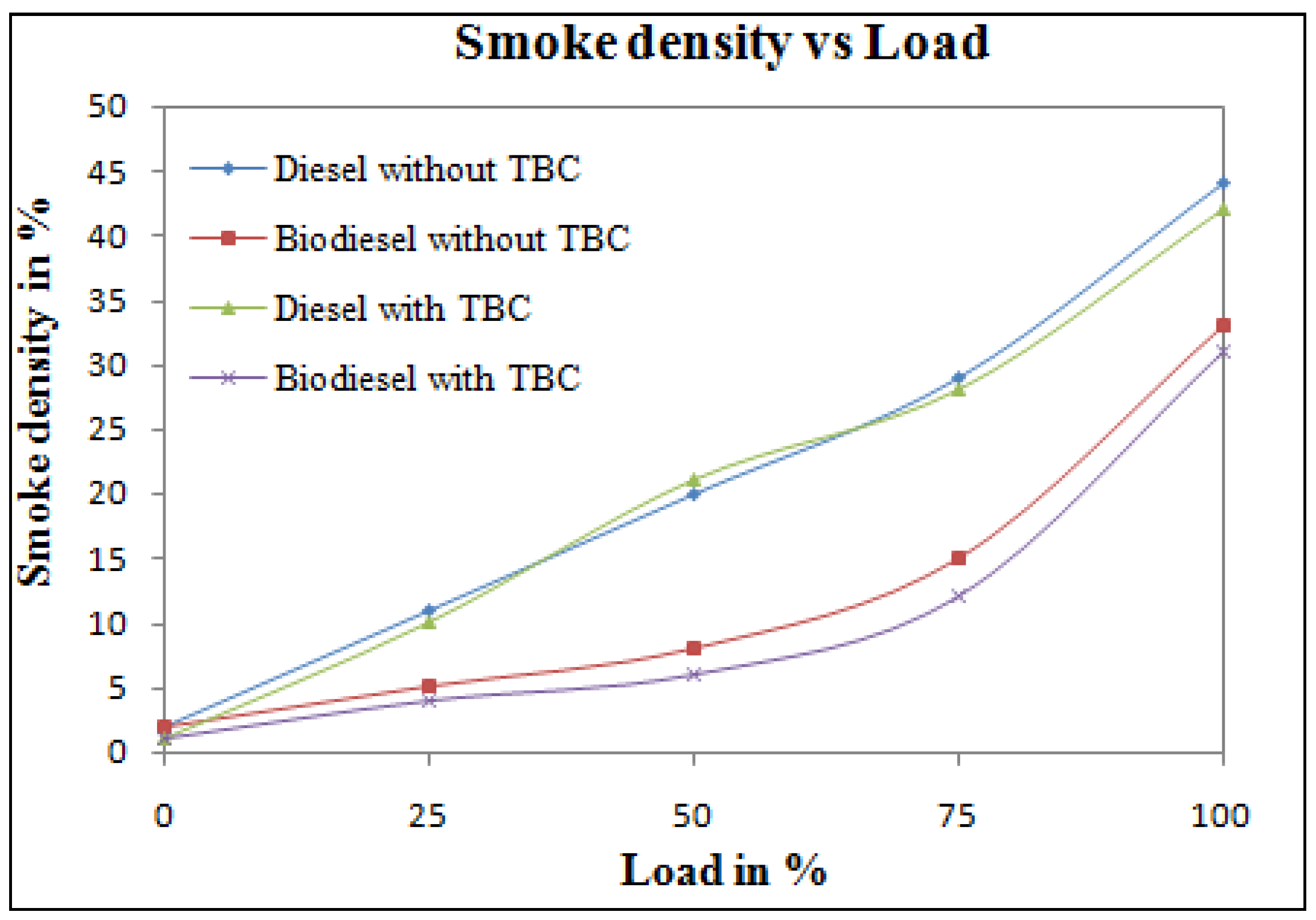

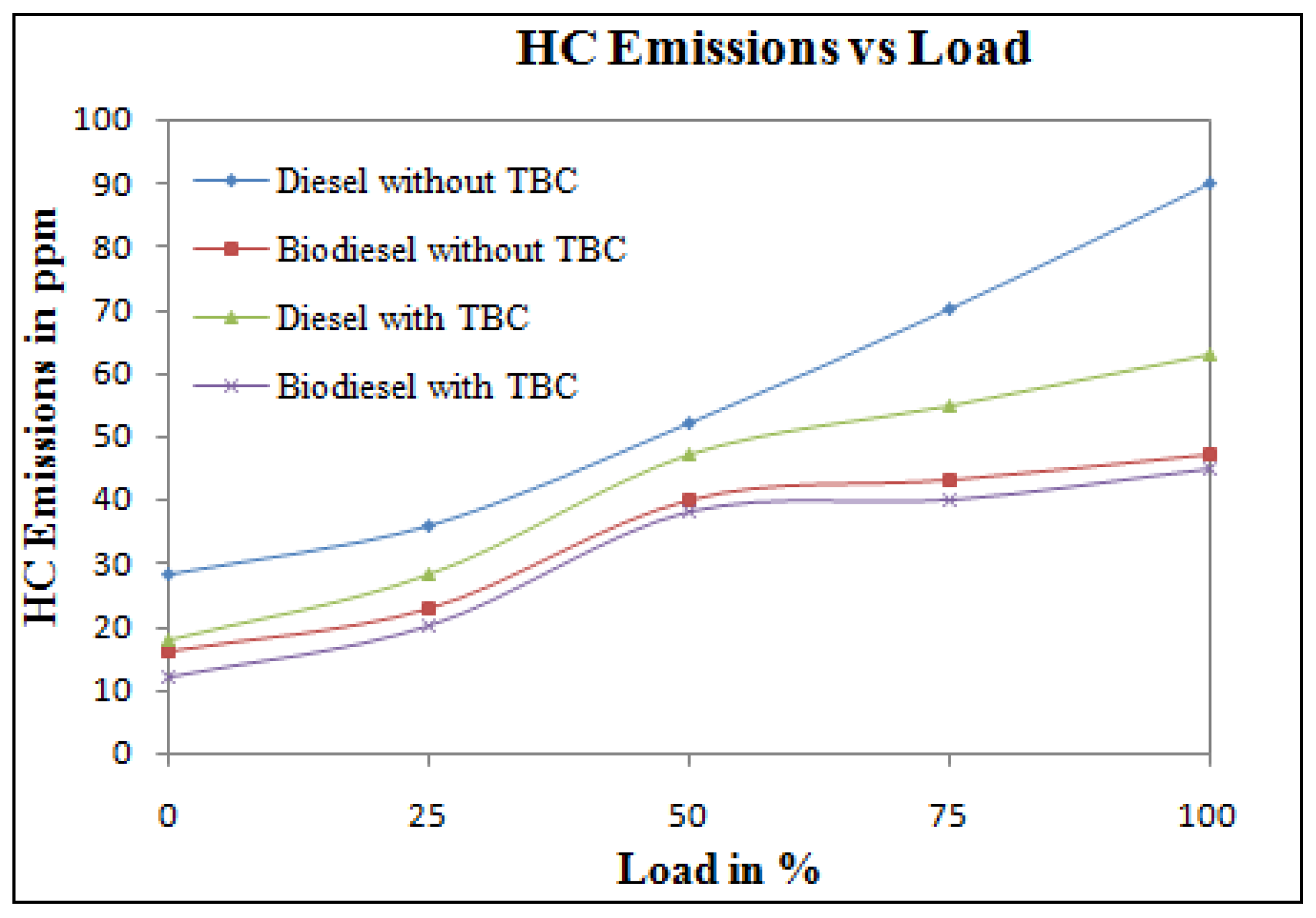

| Name | Properties | ||||
|---|---|---|---|---|---|
| Mullite (3Al2O3-2SiO2) | Melting Point | Poisson’s Ratio | Thermal Conductivity () | Young’s Modulus (E) | Thermal Expansion Coefficient (α) |
| 2123 K | 0.25 | 3.3 W/mk (1400 K) | 127 GPa (293 K) | 5.3 × 10−6 (293–1273 K) | |
| Properties | Diesel | MME | Test-Method | Instruments Used |
|---|---|---|---|---|
| Density(15 °C), kg/m3 | 835 | 872 | EN ISO 3675/EN ISO 12185 | Hydrometer |
| Specific gravity | 0.850 | 0.916 | ASTM D792 | Hydrometer |
| Kinematic viscosity at 40 °C, mm2/s | 2.4 | 4.0 | EN ISO 3104/EN 14105 | Redwood Viscometer |
| Calorific value (KJ/kg) | 42,930 | 39,400 | ASTM D240 | Bomb Calorimeter |
| FlashPoint °C | 70 | 127 | EN ISO 2719/EN ISO 3679 | Pensky-Martens |
| FirePoint °C | 76 | 136 | EN ISO 2719/EN ISO 3679 | Pensky-Martens |
| Cloud point °C | −10 to −15 | 6 | ASTM D2500 | Cloud Point |
| Pour point °C | −35 to −15 | 1 | ASTM D97 | Pour Point |
| Colour | Light brown | Dark yellow | NM | Based on eye visibility |
| Cetane number | 51 | 46 | EN ISO 5165 | [38] |
| Aniline point °C | 69 | 63 | EN 14111 | [38] |
| Iodine value | NM | 60 | ASTM D1959-97 | [38] |
| Diesel index | 150 | 145 | NM | [38] |
| Name of the Specifications | Values |
|---|---|
| Name of Engine | Kirloskar |
| Stroke | 4 |
| Type of cooling | Water Cooled |
| Loading Type | Eddy Current Dynamometer |
| BHP | 5 |
| Stroke length | 110 mm |
| Bore | 80 mm |
| No. of Cylinder | 1 |
| Compression Ratio | 16.5:1 |
| Speed | 1500 rpm |
| Fuel Injection Pressure | 200 bar |
| Rated output | 3.68 kw (5.0 hp) |
| Connecting Rod Length | 230.0 mm |
| Exhaust Valve Open | 20° BBDC [39] |
| Exhaust Valve Closes | 20° ATDC [39] |
| Inlet Valve Open | 20°BTDC [39] |
| Inlet Valve Close | 25° ATDC [39] |
| Injection Advance | 27° BTDC |
| S. No. | Measured Parameter | Specification |
|---|---|---|
| 1 | Oxygen | 0–22% vol. |
| 2 | Carbon monoxide | 0–10% vol. |
| 3 | Carbon dioxide | 0–20% vol. |
| 4 | Hydro carbon | 0–20,000 ppm |
| 5 | Nitrogen oxide | 0–5000 ppm |
| 6 | Engine speed | 400–6000 rpm |
| 7 | Oil temperature | 30–125 °C |
| 8 | Lambda | 0 to 9.999 |
| S. No. | Measured Parameter | Specification |
|---|---|---|
| 1 | Oxygen | <2% vol.: ±0.1% vol. >2% vol.: ±1% vol. |
| 2 | Carbon monoxide | <0.6% vol.: ±0.03% vol. >0.6% vol.: ±5% vol. |
| 3 | Carbon dioxide | <10% vol.: ±0.5% vol. >10% vol.: ±5% vol. |
| 4 | Hydro carbon | <200 ppm: ±10 ppm >200 ppm ±5% of ind. value |
| 5 | Nitrogen oxide | <5000 ppm: ±50 ppm |
| 6 | Engine speed | ±1% of ind. value |
| 7 | Oil temperature | ±4 °C |
| Type | Values/Model |
|---|---|
| Make and Model | AVL 437C Smoke meter |
| Sampling type | Partial flow |
| Light source | Halogen Lamp, 12 V/5 W |
| Range | 0–100% opacity, 0–99.99 m−1 absorption |
| RPM | 400–6000 in |
| Parameters | Percentage Uncertainties |
|---|---|
| Brake power | ±0.5 |
| Brake specific fuel consumption | ±1.5 |
| Brake thermal efficiency | ±1.0 |
Publisher’s Note: MDPI stays neutral with regard to jurisdictional claims in published maps and institutional affiliations. |
© 2022 by the authors. Licensee MDPI, Basel, Switzerland. This article is an open access article distributed under the terms and conditions of the Creative Commons Attribution (CC BY) license (https://creativecommons.org/licenses/by/4.0/).
Share and Cite
Vijay Kumar, M.; Srinivas Reddy, T.; Rami Reddy, C.; Rami Reddy, S.V.; Alsharef, M.; Alharbi, Y.; Alamri, B. Impact of a Thermal Barrier Coating in Low Heat Rejection Environment Area of a Diesel Engine. Sustainability 2022, 14, 15801. https://doi.org/10.3390/su142315801
Vijay Kumar M, Srinivas Reddy T, Rami Reddy C, Rami Reddy SV, Alsharef M, Alharbi Y, Alamri B. Impact of a Thermal Barrier Coating in Low Heat Rejection Environment Area of a Diesel Engine. Sustainability. 2022; 14(23):15801. https://doi.org/10.3390/su142315801
Chicago/Turabian StyleVijay Kumar, Megavath, Thumu Srinivas Reddy, Ch. Rami Reddy, S. Venkata Rami Reddy, Mohammad Alsharef, Yasser Alharbi, and Basem Alamri. 2022. "Impact of a Thermal Barrier Coating in Low Heat Rejection Environment Area of a Diesel Engine" Sustainability 14, no. 23: 15801. https://doi.org/10.3390/su142315801






